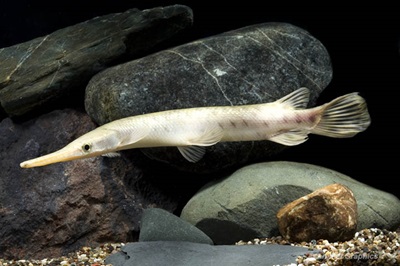
SKU: H806

Freshwater Gars Care Tips
In Stock
Out of Stock
Temporarily Out of Stock
Discontinued
Special Order
Price:
Product Details
Gars
Gars are large predatory fish that are sometimes kept in large aquariums. They are members of the Lepisosteus family that inhabit freshwater and brackish water of North America, Central America, and the Caribbean islands.
Housing: These fish can grow quite large and adults will require tanks that are 6 foot long or more. They should have plenty of swimming room and a tight fitting cover, as they can jump. There should be some space between the glass cover and the water level so that the gar can gulp air. Gars are hardy and tolerant of most water conditions. Maintain good filtration with power filters, but avoid excessive water current.
Temperature: 70-80 F pH: 7.0-8.0
Tank Mates: You can keep them as singles or groups. Gars will not harm any fish that they can not swallow, but will quickly devour small fish. If your tank is large enough you can mix them with oscars, catfish, large tinfoil barbs, large severums, and large blood parrots. Do not mix them with aggressive fish.
Feeding: They are carnivores. Feed live feeder fish, ghost shrimp, crickets, crayfish. Sometimes they will accept frozen krill.
Florida Longnose Gar (Lepisosteus platyrhincus) (Grows 24-36") Florida Gar are some of the smaller in the gar family, they average around 3 feet in length. They are found in medium and large lowland streams, canals, and lakes with muddy or sandy bottoms underneath dense vegetation. The Florida Gar possess an air bladder organ that acts as an auxiliary lung which allows them to thrive in low oxygenated water. Make sure to pick a soft substrate and provide live plants, rockwork, and driftwood. This species would not be happy in a tank with a lot of open space, providing plenty of hiding spots will ensure that your gar stays happy, healthy, and they will feel more comfortable to venture out into view in the tank.
Alligator Gar (Atractosteus spatula) (Grows to 96")
The alligator gar is the largest freshwater fish found in North America. Females are always larger than males, the largest recorded catch was 10 foot, 350 pounds. In the aquarium, alligator gars tend to average out around 4-6 feet in length. Their average life span is 35 years. Provide a tank with soft sandy substrate, live plants, driftwood, and rockwork. But, also keep in mind how large this fish will become. Providing optimal hiding spaces but also enough swimming room for a fish that will be several feet in length is essential.
North American Spotted Gar (Lepisosteus oculatus) (Grows 36-40") In their northern range, these fish are found throughout the Lake Erie through Lake Michigan drainages. They are also found in the Mississippi river, down towards the gulf of Mexico, along Texas and Florida. They are usually found in shallower water (3-5 feet in depth) in areas where there is overgrown vegetation, fallen trees, and overhanging branches. Due to this, they prefer a tank that is planted, covered in rockwork, and driftwood.
Tropical Gar (Atractosteus tropicus) (Grows 36-48") Found in Caribbean and Pacific Rivers, enters the estuaries of pacific drainages. Like other gars, provide a tank with plenty of hiding spots. This Gar is rare, and not very commonly seen in the aquarium trade.
Fish that are Referred to as Gars -
Hujeta Gar (Ctenolucius hujeta) (Grows to 9") Freshwater Barracuda, Gar Characin, Rocket Gar.
These fish are actually not gars, their Genus refers to pike-characins. They are merely called Gars because of their appearance being so similar. Their behavior is similar to that of gars, they are ambush predators who enjoy floating in the mid to upper levels of the tank. Keep them with fish that they cannot swallow. These gar can be mixed in with community tanks if done so thoughtfully.
Marble Gar (Boulengerella maculata) (Grows to- 12") Also called the Spotted Pike Characin. These fish are actually not gars, their Genus refers to pike-characins. They are merely called Gars because of their appearance being so similar. From South America. These fish occupy a vast area of tropical South America, occupying the main channels of several large river systems.
Gars are large predatory fish that are sometimes kept in large aquariums. They are members of the Lepisosteus family that inhabit freshwater and brackish water of North America, Central America, and the Caribbean islands.
Housing: These fish can grow quite large and adults will require tanks that are 6 foot long or more. They should have plenty of swimming room and a tight fitting cover, as they can jump. There should be some space between the glass cover and the water level so that the gar can gulp air. Gars are hardy and tolerant of most water conditions. Maintain good filtration with power filters, but avoid excessive water current.
Temperature: 70-80 F pH: 7.0-8.0
Tank Mates: You can keep them as singles or groups. Gars will not harm any fish that they can not swallow, but will quickly devour small fish. If your tank is large enough you can mix them with oscars, catfish, large tinfoil barbs, large severums, and large blood parrots. Do not mix them with aggressive fish.
Feeding: They are carnivores. Feed live feeder fish, ghost shrimp, crickets, crayfish. Sometimes they will accept frozen krill.
Florida Longnose Gar (Lepisosteus platyrhincus) (Grows 24-36") Florida Gar are some of the smaller in the gar family, they average around 3 feet in length. They are found in medium and large lowland streams, canals, and lakes with muddy or sandy bottoms underneath dense vegetation. The Florida Gar possess an air bladder organ that acts as an auxiliary lung which allows them to thrive in low oxygenated water. Make sure to pick a soft substrate and provide live plants, rockwork, and driftwood. This species would not be happy in a tank with a lot of open space, providing plenty of hiding spots will ensure that your gar stays happy, healthy, and they will feel more comfortable to venture out into view in the tank.
Alligator Gar (Atractosteus spatula) (Grows to 96")
The alligator gar is the largest freshwater fish found in North America. Females are always larger than males, the largest recorded catch was 10 foot, 350 pounds. In the aquarium, alligator gars tend to average out around 4-6 feet in length. Their average life span is 35 years. Provide a tank with soft sandy substrate, live plants, driftwood, and rockwork. But, also keep in mind how large this fish will become. Providing optimal hiding spaces but also enough swimming room for a fish that will be several feet in length is essential.
North American Spotted Gar (Lepisosteus oculatus) (Grows 36-40") In their northern range, these fish are found throughout the Lake Erie through Lake Michigan drainages. They are also found in the Mississippi river, down towards the gulf of Mexico, along Texas and Florida. They are usually found in shallower water (3-5 feet in depth) in areas where there is overgrown vegetation, fallen trees, and overhanging branches. Due to this, they prefer a tank that is planted, covered in rockwork, and driftwood.
Tropical Gar (Atractosteus tropicus) (Grows 36-48") Found in Caribbean and Pacific Rivers, enters the estuaries of pacific drainages. Like other gars, provide a tank with plenty of hiding spots. This Gar is rare, and not very commonly seen in the aquarium trade.
Fish that are Referred to as Gars -
Hujeta Gar (Ctenolucius hujeta) (Grows to 9") Freshwater Barracuda, Gar Characin, Rocket Gar.
These fish are actually not gars, their Genus refers to pike-characins. They are merely called Gars because of their appearance being so similar. Their behavior is similar to that of gars, they are ambush predators who enjoy floating in the mid to upper levels of the tank. Keep them with fish that they cannot swallow. These gar can be mixed in with community tanks if done so thoughtfully.
Marble Gar (Boulengerella maculata) (Grows to- 12") Also called the Spotted Pike Characin. These fish are actually not gars, their Genus refers to pike-characins. They are merely called Gars because of their appearance being so similar. From South America. These fish occupy a vast area of tropical South America, occupying the main channels of several large river systems.
| Product PDF: | |
|---|---|
| Extra Details: |



